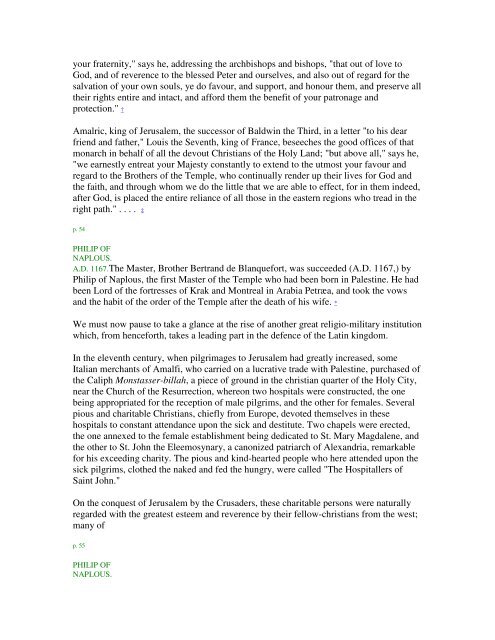The History of the Knights Templar by Charles G ... - Masonic Renewal
The History of the Knights Templar by Charles G ... - Masonic Renewal
The History of the Knights Templar by Charles G ... - Masonic Renewal
Create successful ePaper yourself
Turn your PDF publications into a flip-book with our unique Google optimized e-Paper software.
your fraternity," says he, addressing <strong>the</strong> archbishops and bishops, "that out <strong>of</strong> love to<br />
God, and <strong>of</strong> reverence to <strong>the</strong> blessed Peter and ourselves, and also out <strong>of</strong> regard for <strong>the</strong><br />
salvation <strong>of</strong> your own souls, ye do favour, and support, and honour <strong>the</strong>m, and preserve all<br />
<strong>the</strong>ir rights entire and intact, and afford <strong>the</strong>m <strong>the</strong> benefit <strong>of</strong> your patronage and<br />
protection." †<br />
Amalric, king <strong>of</strong> Jerusalem, <strong>the</strong> successor <strong>of</strong> Baldwin <strong>the</strong> Third, in a letter "to his dear<br />
friend and fa<strong>the</strong>r," Louis <strong>the</strong> Seventh, king <strong>of</strong> France, beseeches <strong>the</strong> good <strong>of</strong>fices <strong>of</strong> that<br />
monarch in behalf <strong>of</strong> all <strong>the</strong> devout Christians <strong>of</strong> <strong>the</strong> Holy Land; "but above all," says he,<br />
"we earnestly entreat your Majesty constantly to extend to <strong>the</strong> utmost your favour and<br />
regard to <strong>the</strong> Bro<strong>the</strong>rs <strong>of</strong> <strong>the</strong> Temple, who continually render up <strong>the</strong>ir lives for God and<br />
<strong>the</strong> faith, and through whom we do <strong>the</strong> little that we are able to effect, for in <strong>the</strong>m indeed,<br />
after God, is placed <strong>the</strong> entire reliance <strong>of</strong> all those in <strong>the</strong> eastern regions who tread in <strong>the</strong><br />
right path." . . . . ‡<br />
p. 54<br />
PHILIP OF<br />
NAPLOUS.<br />
A.D. 1167.<strong>The</strong> Master, Bro<strong>the</strong>r Bertrand de Blanquefort, was succeeded (A.D. 1167,) <strong>by</strong><br />
Philip <strong>of</strong> Naplous, <strong>the</strong> first Master <strong>of</strong> <strong>the</strong> Temple who had been born in Palestine. He had<br />
been Lord <strong>of</strong> <strong>the</strong> fortresses <strong>of</strong> Krak and Montreal in Arabia Petræa, and took <strong>the</strong> vows<br />
and <strong>the</strong> habit <strong>of</strong> <strong>the</strong> order <strong>of</strong> <strong>the</strong> Temple after <strong>the</strong> death <strong>of</strong> his wife. *<br />
We must now pause to take a glance at <strong>the</strong> rise <strong>of</strong> ano<strong>the</strong>r great religio-military institution<br />
which, from henceforth, takes a leading part in <strong>the</strong> defence <strong>of</strong> <strong>the</strong> Latin kingdom.<br />
In <strong>the</strong> eleventh century, when pilgrimages to Jerusalem had greatly increased, some<br />
Italian merchants <strong>of</strong> Amalfi, who carried on a lucrative trade with Palestine, purchased <strong>of</strong><br />
<strong>the</strong> Caliph Monstasser-billah, a piece <strong>of</strong> ground in <strong>the</strong> christian quarter <strong>of</strong> <strong>the</strong> Holy City,<br />
near <strong>the</strong> Church <strong>of</strong> <strong>the</strong> Resurrection, whereon two hospitals were constructed, <strong>the</strong> one<br />
being appropriated for <strong>the</strong> reception <strong>of</strong> male pilgrims, and <strong>the</strong> o<strong>the</strong>r for females. Several<br />
pious and charitable Christians, chiefly from Europe, devoted <strong>the</strong>mselves in <strong>the</strong>se<br />
hospitals to constant attendance upon <strong>the</strong> sick and destitute. Two chapels were erected,<br />
<strong>the</strong> one annexed to <strong>the</strong> female establishment being dedicated to St. Mary Magdalene, and<br />
<strong>the</strong> o<strong>the</strong>r to St. John <strong>the</strong> Eleemosynary, a canonized patriarch <strong>of</strong> Alexandria, remarkable<br />
for his exceeding charity. <strong>The</strong> pious and kind-hearted people who here attended upon <strong>the</strong><br />
sick pilgrims, clo<strong>the</strong>d <strong>the</strong> naked and fed <strong>the</strong> hungry, were called "<strong>The</strong> Hospitallers <strong>of</strong><br />
Saint John."<br />
On <strong>the</strong> conquest <strong>of</strong> Jerusalem <strong>by</strong> <strong>the</strong> Crusaders, <strong>the</strong>se charitable persons were naturally<br />
regarded with <strong>the</strong> greatest esteem and reverence <strong>by</strong> <strong>the</strong>ir fellow-christians from <strong>the</strong> west;<br />
many <strong>of</strong><br />
p. 55<br />
PHILIP OF<br />
NAPLOUS.



